Salvin’s Albatross (Thalassarche salvini) is a majestic seabird inhabiting the Southern Ocean’s remote reaches, captivating researchers and bird enthusiasts alike with its impressive wingspan and unique life history.
Named after the British ornithologist Osbert Salvin, this iconic species boasts distinctive physical characteristics and fascinating behavioral adaptations tailored to its pelagic lifestyle.
With a wingspan spanning up to 260 centimeters, Salvin’s Albatross effortlessly traverses vast expanses of ocean in search of food and suitable breeding sites.
Its opportunistic feeding habits, colonial nesting behavior, and long-distance migrations make it a subject of intrigue and study in avian ecology and conservation.
Through understanding the intricacies of Salvin’s Albatross’s biology and behavior, we gain valuable insights into the challenges and resilience of seabirds in the face of environmental change. Stay sharp.
Pick Out Characteristics of Salvin’s Albatross
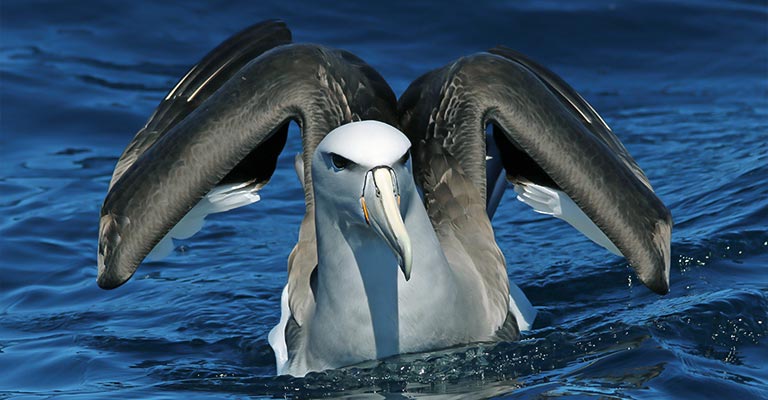
Salvin’s Albatross (Thalassarche salvini) is a majestic seabird belonging to the family Diomedeidae, commonly known as albatrosses.
Named after the British ornithologist Osbert Salvin, this species is renowned for its impressive wingspan and graceful flight over the open ocean.
Identifying Salvin’s Albatross requires keen observation of its distinctive physical characteristics and behavior. Here are some of the key points to help identify this specific bird:
Size and Shape
Salvin’s Albatross is a large seabird with a wingspan ranging from 220 to 260 centimeters (86 to 102 inches). Its body is relatively compact compared to other albatross species, giving it a robust appearance in flight.
Plumage
The plumage of Salvin’s Albatross is predominantly white, with dark markings on the upper wings and back. The head, neck, and underparts are primarily white, while the upper wings display a dark coloration with distinct patterns.
Bill and Facial Features
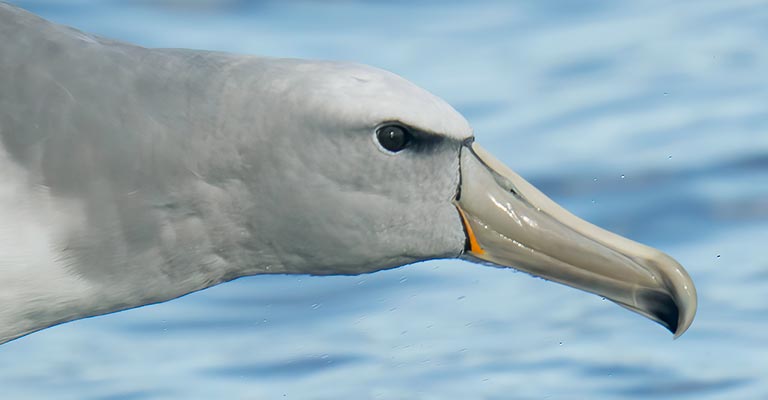
One of the distinguishing features of Salvin’s Albatross is its pale yellow bill with a dark tip.
The bill is relatively slender and slightly hooked at the tip. The face may have dark smudging around the eyes, contrasting with the white plumage.
Flight Pattern
Salvin’s Albatross exhibits a characteristic gliding motion when in flight, with long, broad wings held stiffly above the body.
It often utilizes dynamic soaring techniques to ride wind currents over the ocean surface, covering vast distances with minimal effort.
Tail
The tail of Salvin’s Albatross is relatively short compared to other albatross species, with a squared-off shape. It may have faint barring or mottling on the underside, visible during flight.
Behavior at Sea
Salvin’s Albatross is primarily pelagic, spending most of its life on the open ocean.
It is often observed following ships or scavenging for food near fishing vessels, where it may interact with other seabirds, such as petrels and shearwaters.
Breeding Habitat
During the breeding season, Salvin’s Albatross nests on remote islands in the Southern Ocean, particularly in the subantarctic regions.
Breeding colonies are typically situated on steep coastal cliffs or tussock-covered slopes, where they form monogamous pairs and raise their chicks.
Vocalizations
Like other albatross species, Salvin’s Albatross produces a variety of vocalizations, including haunting wails and grunts, especially during courtship displays and interactions at the breeding colonies.
Identifying Salvin’s Albatross involves recognizing its size, plumage patterns, bill coloration, flight behavior, and habitat preferences.
By paying attention to these critical characteristics, birdwatchers and researchers can confidently distinguish this magnificent seabird from other species within the albatross family.
Taxonomy of Salvin’s Albatross
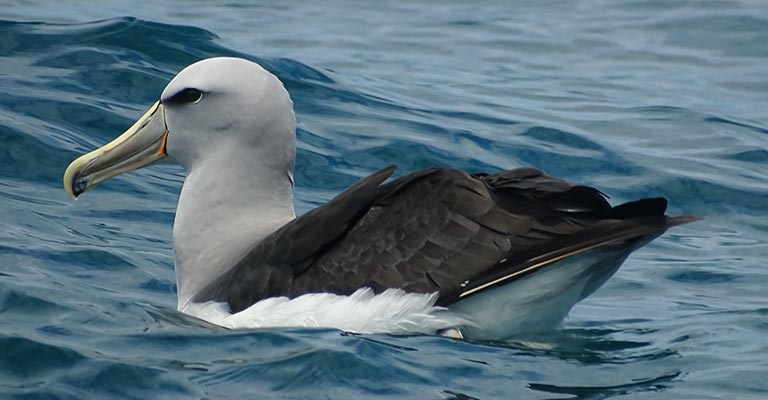
Check out the table below detailing the taxonomy of Salvin’s Albatross:
| Taxonomic Rank | Classification |
| Domain | Eukaryota |
| Kingdom | Animalia |
| Phylum | Chordata |
| Class | Aves |
| Order | Phaethontiformes |
| Family | Diomedeidae |
| Genus | Thalassarche |
| Species | T. salvini |
Salvin’s Albatross (Thalassarche salvini) belongs to the family Diomedeidae, which comprises large seabirds known as albatrosses.
Within this family, Salvin’s Albatross is classified under the genus Thalassarche, which includes several other species of albatrosses.
The genus Thalassarche is further categorized into Procellariiformes and other seabird groups such as petrels, shearwaters, and storm petrels.
Procellariiformes are characterized by their tubular nostrils, which help excrete excess salt from seawater ingested while feeding.
Albatrosses, including Salvin’s Albatross, are renowned for their impressive wingspan, efficient gliding flight, and pelagic lifestyle, making them integral components of marine ecosystems across the world’s oceans.
Hunting Habit of Salvin’s Albatross
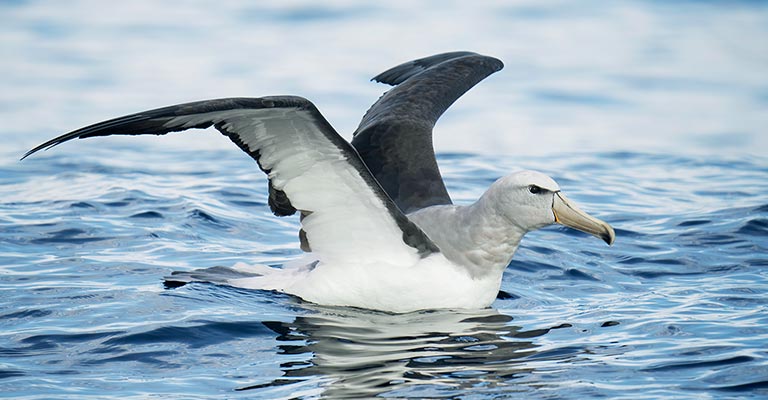
Salvin’s Albatross is an opportunistic feeder with a hunting habit primarily focused on scavenging and surface-seizing prey.
While at sea, it relies on its keen sense of smell to detect food sources, including fish, squid, and crustaceans. This Albatross often follows fishing vessels, using discarded offal and bait as easy meals.
Additionally, it actively searches for prey near the water’s surface, using its sharp eyesight to spot potential targets such as small fish or squid.
Salvin’s Albatross is also known to engage in kleptoparasitic behavior, stealing food from other seabirds through aerial piracy.
Its hunting strategy is opportunistic and adapted to the dynamic and unpredictable nature of the ocean environment, allowing it to sustain its large size and energy demands while roaming the vast expanses of the open sea.
Salvin’s Albatross Life History
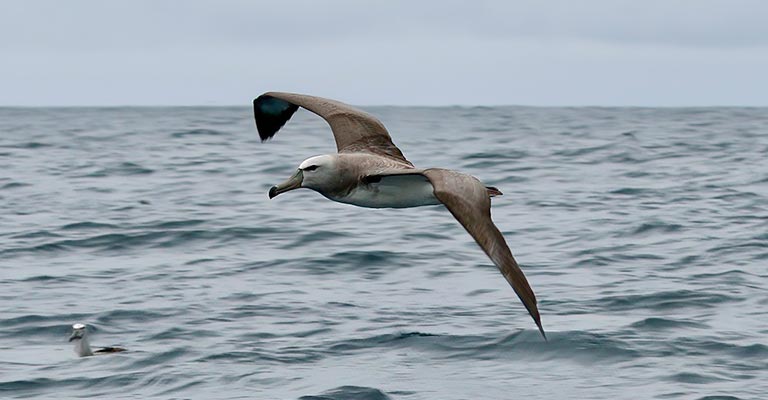
Salvin’s Albatross (Thalassarche salvini) is a fascinating seabird species renowned for its graceful flight over the open ocean and remarkable life history.
Salvin’s Albatross offers insights into the intricacies of avian life in the remote reaches of the Southern Ocean, from its feeding habits to nesting behavior and breeding ecology to conservation status.
Food
Salvin’s Albatross is a carnivorous species with a varied diet that includes fish, squid, crustaceans, and occasionally carrion. It relies on its keen sense of smell and sharp eyesight to locate prey while foraging over vast expanses of the ocean.
Habitat and Range Map
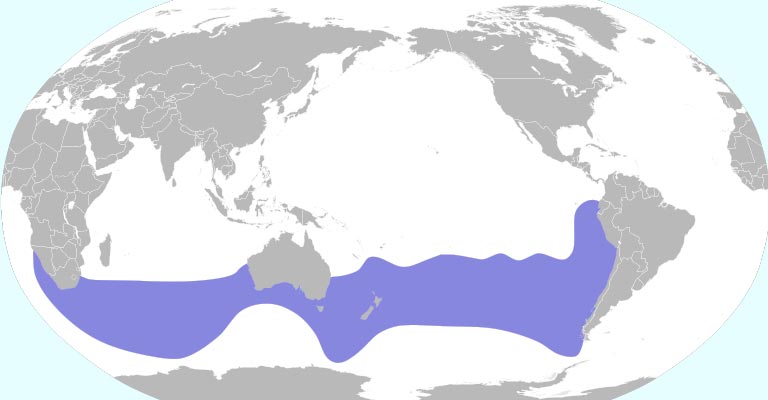
This albatross species is primarily pelagic, spending most of its life in the open ocean.
Its range extends across the Southern Ocean, with breeding colonies on remote subantarctic islands such as the Falklands, South Georgia, and the Auckland Islands.
Nesting and Breeding
Breeding colonies of Salvin’s Albatross are established on steep coastal cliffs or tussock-covered slopes of remote islands. These birds form monogamous pairs and return to the same nesting site year after year.
The female lays a single egg, which both parents take turns incubating for approximately two months. After hatching, the chick is cared for by both parents and fledges after about five to six months.
A table detailing the nesting details of Salvin’s Albatross is given below:
| Nesting Details | Description |
| Clutch Size | Typically, one brood per season |
| Number of Broods | Large, oval-shaped with a white shell, sometimes with light brown speckles or spots |
| Egg Length | Approximately 12 to 13 centimeters |
| Egg Width | Approximately 7 to 8 centimeters |
| Incubation Period | Around 65 to 70 days |
| Nestling Period | Approximately 5 to 6 months |
| Egg Description | Simple scrape in the ground, often lined with grass, feathers, or other vegetation. |
| Nest Construction | Both parents take turns incubating the egg, with shifts lasting several days. |
| Incubation Behavior | Both parents feed and care for the chick, regurgitating food from their stomachs. |
| Chick Rearing | Chicks fledge and leave the nest site after gaining enough strength and body mass. |
| Fledging | Chicks fledge and leave the nest site after gaining enough strength and body mass |
This table summarizes various aspects of Salvin’s Albatross nesting behavior, from egg characteristics to incubation and chick-rearing practices.
Diseases and Treatment
Salvin’s Albatross, like other seabird species, is susceptible to various diseases and parasites, including avian pox and avian cholera.
Conservation efforts often include monitoring and treating affected individuals to mitigate the impact of these threats on population health.
Conservation
Salvin’s Albatross faces numerous conservation challenges, including habitat destruction, fisheries bycatch, and invasive species predation.
Conservation efforts focus on habitat protection, reducing bycatch in fisheries, and mitigating the impact of invasive species on breeding colonies.
International agreements such as the Agreement on the Conservation of Albatrosses and Petrels (ACAP) aim to coordinate conservation actions across range states to ensure the long-term survival of this iconic seabird species.
Salvin’s Albatross exemplifies the resilience and adaptability of seabirds in the face of environmental challenges.
By understanding its intricate life history and implementing effective conservation measures, we can work towards safeguarding the future of this magnificent species for generations to come.
Behavioral Habits of Salvin’s Albatross
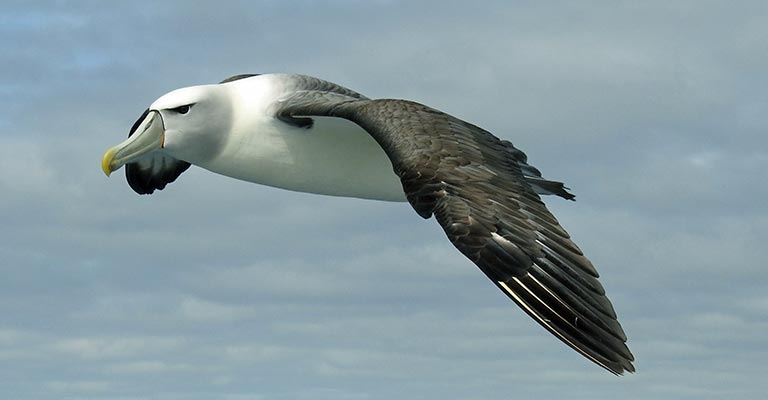
Salvin’s Albatross exhibits a range of fascinating behavioral habits that contribute to its survival and success in the open ocean environment.
From foraging techniques to social interactions, these behaviors reflect the unique adaptations of this seabird species.
Dynamic Soaring
One of the most remarkable behaviors of Salvin’s Albatross is its adeptness at dynamic soaring.
These birds can efficiently cover vast distances with minimal energy expenditure by exploiting wind gradients and air currents near the ocean surface.
This skill enables them to travel thousands of kilometers searching for food and suitable breeding sites.
Scavenging
Salvin’s Albatross is an opportunistic feeder that often scavenges for food near fishing vessels or feeding aggregations of other marine animals.
They capitalize on discarded offal, bait, and other organic matter, displaying remarkable agility in snatching prey from the water’s surface.
Kleptoparasitism
In addition to scavenging, Salvin’s Albatross engages in kleptoparasitic behavior, opportunistically stealing food from other seabirds through aerial piracy.
They skillfully intercept prey captured by other species, such as smaller petrels or shearwaters, demonstrating their ability to exploit various food sources in the highly competitive marine environment.
Courtship Displays
During the breeding season, Salvin’s Albatross engages in elaborate courtship displays to attract mates and reinforce pair bonds.
These displays often involve aerial acrobatics, bill fencing, and mutual preening, showcasing the bird’s prowess and commitment to reproductive success.
Colonial Nesting
Salvin’s Albatross nests in densely packed colonies on remote subantarctic islands, where they form monogamous pairs and raise their chicks cooperatively.
This colonial nesting behavior provides opportunities for social interactions, mate selection, and shared defense against predators, contributing to the species’ reproductive success and genetic diversity.
Long-Distance Migration
Outside the breeding season, Salvin’s Albatross undertakes long-distance migrations across the Southern Ocean, following seasonal shifts in food availability and oceanic currents.
These migrations may cover thousands of kilometers and require precise navigation skills honed through generations of evolutionary adaptation.
The behavioral habits of Salvin’s Albatross reflect its remarkable adaptability to the challenges of life at sea.
From efficient foraging strategies to intricate social interactions, these behaviors underscore the resilience and resourcefulness of this iconic seabird species.
Wrapping Up
Salvin’s Albatross stands as a symbol of resilience and adaptability in the harsh and dynamic environment of the open ocean.
Its majestic flight, opportunistic feeding behaviors, and cooperative nesting strategies exemplify the remarkable survival mechanisms that evolved over millennia.
Despite facing threats such as habitat destruction, fisheries bycatch, and climate change, concerted conservation efforts offer hope for the long-term preservation of this iconic seabird species.
By understanding and appreciating the intricate complexities of Salvin’s Albatross’s life history and behaviors, we can work towards ensuring a brighter future for this magnificent bird and the delicate ecosystems it inhabits.
Through collaboration and conservation action, we can strive to protect the legacy of Salvin’s Albatross for generations to come. Thank you so much.